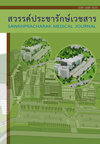ผลของการให้ glycopyrrolate ก่อนการนำสลบเพื่อช่วยลดภาวะแทรกซ้อนจากยา propofol และลดสารคัดหลั่งขณะจัดท่าทาง ในผู้ป่วยผ่าตัดนิ่วที่ไตและท่อไตแบบเปิด
คำสำคัญ:
ยา Propofol, ความดันโลหิตต่ำ, ภาวะหัวใจเต้นช้า, สารคัดหลั่งในช่องปากบทคัดย่อ
วัตถุประสงค์ : เพื่อศึกษาประสิทธิภาพของยา glycopyrrolate ในการป้องกันภาวะแทรกซ้อนของระบบหัวใจและหลอดเลือด และลดสารคัดหลั่งหลังการนำสลบด้วยยา propofol
สถานที่ศึกษา : ห้องผ่าตัดชั้น 4 โรงพยาบาลสวรรค์ประชารักษ์
รูปแบบการวิจัย : การวิจัยเชิงทดลองแบบสุ่มชนิดมีกลุ่มควบคุมแบบปกปิดสองทาง
กลุ่มตัวอย่าง : ผู้ป่วยผ่าตัด open urologic surgery, ASA physical status I-II จำนวน 64 คน
วิธีการศึกษา : แบ่งผู้ป่วยเป็น 2 กลุ่มโดยวิธีการสุ่ม กลุ่มควบคุม (Group C) จะได้รับ normal saline 1 มิลลิลิตร และกลุ่มทดลอง (Group G) จะได้รับยา glycopyrrolate 0.2 มิลลิกรัม โดยแบ่งให้ครั้งละ 0.1 มิลลิกรัม ที่เวลา 0 และ 2 นาที ก่อนใส่ท่อช่วยหายใจ ผู้ป่วยทุกคนได้รับการนำสลบด้วยยา propofol 2.5 มิลลิกรัมต่อกิโลกรัม โดยแบ่งให้ช้า ๆ และยา cisatracurium 0.2 มิลลิกรัมต่อกิโลกรัม ทำการใส่ท่อช่วยหายใจที่เวลา 5 นาที หลังให้ยา propofol บันทึกความดันโลหิต อัตราการเต้นของหัวใจ และปริมาณน้ำลาย ที่เวลา 2, 3, 5, 5.5 (ขณะใส่ท่อช่วยหายใจ) และ 7 นาที
ผลการศึกษา : ผู้ป่วยทั้งสองกลุ่มมีภาวะความดันโลหิตต่ำ (ร้อยละ 56.3 และร้อยละ 34.4, p-value = 0.13) ไม่แตกต่างกันอย่างมีนัยสำคัญทางสถิติ แต่พบว่ากลุ่มที่ได้รับยา glycopyrrolate มีภาวะหัวใจเต้นช้า (ร้อยละ 15.6 และร้อยละ 7.8 , p-value=0.05) และมีปริมาณสารคัดหลั่งภายในช่องปาก (9.5 และ 0.5 มิลลิลิตร, p-value < 0.01) น้อยกว่าอย่างมีนัยสำคัญทางสถิติ
สรุป : ยา glycopyrrolate มีประสิทธิภาพในการป้องกันภาวะหัวใจเต้นช้า ลดสารคัดหลั่งภายในช่องปาก แต่ไม่สามารถป้องกันภาวะความความดันโลหิตต่ำ
คำสำคัญ : ยา Propofol, ความดันโลหิตต่ำ, ภาวะหัวใจเต้นช้า, สารคัดหลั่งในช่องปาก
เอกสารอ้างอิง
Hug CC Jr, McLeskey CH, Nahrwold ML, Roizen MF, Stanley TH, Thisted RA. Hemodynamic effects of propofol: data from over 25,000 patients. Anesth Analg 1993;77:21-9.
Claeys MA, Gepts E, Camu F. Haemodynamic changes during anaesthesia induced and maintained with propofol. Br J Anaesth 1988;60:3-9.
Turner RJ, Gatt SP, Kam PC, Ramzan I, Daley M. Administration of a crystalloid fluid preload does not prevent the decrease in arterial blood pressure after induction of anaesthesia with propofol and fentanyl. British Journal of Anaesthesia 1998;80:
–41.
Michelsen I, Helbo-Hansen HS, Køhler F, Lorenzen AG, Rydlund E, Bentzon MW. Prophylactic ephedrine attenuates the hemodynamic response to propofol in elderly female patients. Anesth Analg 1998;86:477-81.
Mirakhur RK, Clarke RS, Elliott J, Dundee JW. Atropine and glycopyrronium premedication. Anaesthesia, 1978;33(10):906-12.
Mirakhur RK, Dundee JW. Glycopyrrolate: pharmacology and clinical use. Anaesthesia. 1983;38:1195-204.
Greenan J, Dewar M, Jones CJ. Intravenous glycopyrrolate and atropine at induction of anaesthesia: a comparison. J R Soc Med 1983;76:369-71.
Skues MA, Richards MJ, Jarvis AP, Prys-Roberts C. Preinduction atropine or glycopyrrolate and hernodynamic changes associated with induction and maintenance of anesthesia with Propofol and Alfentanil. Anesth Analg 1989;69:386-90.
Ittichaikulthol W, Pisitsak C, Wirachpisit N, Piathong P, Suyawet R, Komonhirun R. A comparison of the combination of atropine and glycopyrrolate with atropine alone for the reversal of muscle relaxant. J Med Assoc Thai 2014;97(7):705-9.
Limapichat R, Phuphiphat L, Pulnitiporn A. A randomized controlled comparison of difference heart rate after the reversal of non-depolarized muscle relaxant with atropine 0.6 mg, 0.9 mg and 1.2 mg plus neostigmine 2.5 mg. Thai J Anesthesiology 2017;43:135-43.
Prasopsuk K, Prasopsuk S, Tunruttanakul S. Evaluation of hypotensive prevention effect of intramuscular glycopyrrolate in spinal anesthesia of elderly TURP patients. Siriraj medical journal 2020;72(5):380-5.
Klingenmaier CH, Bullard R, Thompson D, Watson R. Reversal of neuromuscular blockade with a mixture of neostigmine and glycopyrrolate. Anesth Analg 1972;51:468-72.
Cozanitis DA, Dundee JW, Merrett JD, Jones CJ, Mirakhur RK. Evaluation of glycopyrrolate and atropine as adjuncts to reversal of non-depolarizing neuromuscular blocking agents in a “true-to-life” situation. Br J Anaesth 1980;52:85-9.
Bernstein CA, Waters JH, Torjman MC, Ritter D. Preoperative glycopyrolate oral, intramuscular or intravenous administration. J Clin Anesth 1996;8:515-8.
Hwang J, Min S, Kim C, Gil N, Kim E, Huh J. Prophylactic glycopyrrolate reduces hypotensive responses in elderly patients during spinal anesthesia: a randomized controlled trial. Can J Anesth 2014;61(1):32–8.
คณะอนุกรรมการพัฒนาบัญชียาหลักแห่งชาติ และคณะทำงานผู้เชี่ยวชาญแหงชาติด้านการคัดเลือกยา สาขาวิสัญญีวิทยา และการระงับการปวด. คู่มือการใช้ยาอย่างสมเหตุผลตามบัญชียาหลักแห่งชาติ ยาที่ใช้ทางวิสัญญีวิทยา และการระงับปวด. นนทบุรี: กลุ่มนโยบายแห่งชาติด้านยา สำนักยา สำนักงานคณะกรรมการอาหารและยา; 2559.
ดาวน์โหลด
เผยแพร่แล้ว
วิธีการอ้างอิง
ฉบับ
บท
การอนุญาต

This work is licensed under a Creative Commons Attribution-NonCommercial-NoDerivatives 4.0 International License.




